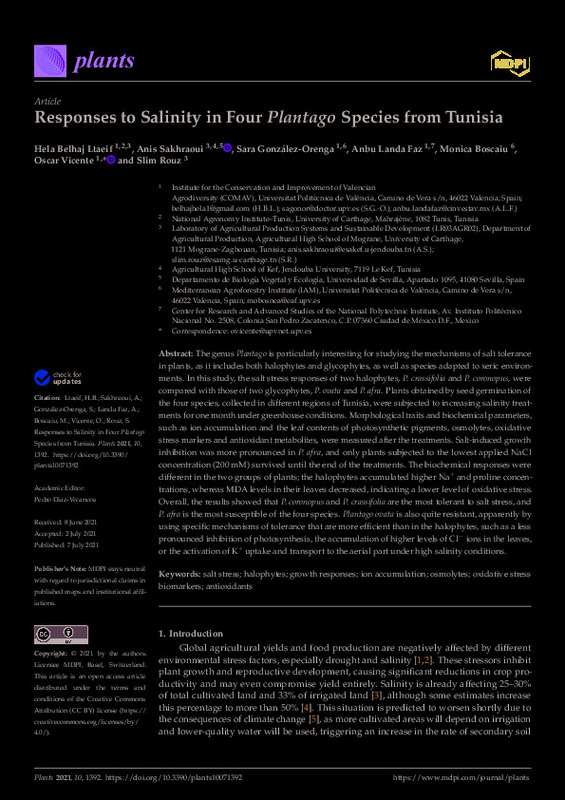JavaScript is disabled for your browser. Some features of this site may not work without it.
Buscar en RiuNet
Listar
Mi cuenta
Estadísticas
Ayuda RiuNet
Admin. UPV
Responses to Salinity in Four Plantago Species from Tunisia
Mostrar el registro sencillo del ítem
Ficheros en el ítem
| dc.contributor.author | Ltaeif, Hela Belhaj
|
es_ES |
| dc.contributor.author | Sakhraoui, Anis
|
es_ES |
| dc.contributor.author | González-Orenga, Sara
|
es_ES |
| dc.contributor.author | Landa Faz, Anbu
|
es_ES |
| dc.contributor.author | Boscaiu, Monica
|
es_ES |
| dc.contributor.author | Vicente, Oscar
|
es_ES |
| dc.contributor.author | Rouz, Slim
|
es_ES |
| dc.date.accessioned | 2022-09-02T18:02:41Z | |
| dc.date.available | 2022-09-02T18:02:41Z | |
| dc.date.issued | 2021-07 | es_ES |
| dc.identifier.uri | http://hdl.handle.net/10251/185164 | |
| dc.description.abstract | [EN] The genus Plantago is particularly interesting for studying the mechanisms of salt tolerance in plants, as it includes both halophytes and glycophytes, as well as species adapted to xeric environments. In this study, the salt stress responses of two halophytes, P. crassifolia and P. coronopus, were compared with those of two glycophytes, P. ovata and P. afra. Plants obtained by seed germination of the four species, collected in different regions of Tunisia, were subjected to increasing salinity treatments for one month under greenhouse conditions. Morphological traits and biochemical parameters, such as ion accumulation and the leaf contents of photosynthetic pigments, osmolytes, oxidative stress markers and antioxidant metabolites, were measured after the treatments. Salt-induced growth inhibition was more pronounced in P. afra, and only plants subjected to the lowest applied NaCl concentration (200 mM) survived until the end of the treatments. The biochemical responses were different in the two groups of plants; the halophytes accumulated higher Na+ and proline concentrations, whereas MDA levels in their leaves decreased, indicating a lower level of oxidative stress. Overall, the results showed that P. coronopus and P. crassifolia are the most tolerant to salt stress, and P. afra is the most susceptible of the four species. Plantago ovata is also quite resistant, apparently by using specific mechanisms of tolerance that are more efficient than in the halophytes, such as a less pronounced inhibition of photosynthesis, the accumulation of higher levels of Cl¿ ions in the leaves, or the activation of K+ uptake and transport to the aerial part under high salinity conditions. | es_ES |
| dc.description.sponsorship | This research was supported by internal funds of Universitat Politecnica de Valencia to O.V. and M.B. | es_ES |
| dc.language | Inglés | es_ES |
| dc.publisher | MDPI | es_ES |
| dc.relation.ispartof | Plants | es_ES |
| dc.rights | Reconocimiento (by) | es_ES |
| dc.subject | Salt stress | es_ES |
| dc.subject | Halophytes | es_ES |
| dc.subject | Growth responses | es_ES |
| dc.subject | Ion accumulation | es_ES |
| dc.subject | Osmolytes | es_ES |
| dc.subject | Oxidative stress biomarkers | es_ES |
| dc.subject | Antioxidants | es_ES |
| dc.subject.classification | BIOQUIMICA Y BIOLOGIA MOLECULAR | es_ES |
| dc.subject.classification | BOTANICA | es_ES |
| dc.title | Responses to Salinity in Four Plantago Species from Tunisia | es_ES |
| dc.type | Artículo | es_ES |
| dc.identifier.doi | 10.3390/plants10071392 | es_ES |
| dc.rights.accessRights | Abierto | es_ES |
| dc.contributor.affiliation | Universitat Politècnica de València. Departamento de Ecosistemas Agroforestales - Departament d'Ecosistemes Agroforestals | es_ES |
| dc.contributor.affiliation | Universitat Politècnica de València. Departamento de Biotecnología - Departament de Biotecnologia | es_ES |
| dc.description.bibliographicCitation | Ltaeif, HB.; Sakhraoui, A.; González-Orenga, S.; Landa Faz, A.; Boscaiu, M.; Vicente, O.; Rouz, S. (2021). Responses to Salinity in Four Plantago Species from Tunisia. Plants. 10(7):1-20. https://doi.org/10.3390/plants10071392 | es_ES |
| dc.description.accrualMethod | S | es_ES |
| dc.relation.publisherversion | https://doi.org/10.3390/plants10071392 | es_ES |
| dc.description.upvformatpinicio | 1 | es_ES |
| dc.description.upvformatpfin | 20 | es_ES |
| dc.type.version | info:eu-repo/semantics/publishedVersion | es_ES |
| dc.description.volume | 10 | es_ES |
| dc.description.issue | 7 | es_ES |
| dc.identifier.eissn | 2223-7747 | es_ES |
| dc.identifier.pmid | 34371595 | es_ES |
| dc.identifier.pmcid | PMC8309215 | es_ES |
| dc.relation.pasarela | S\441869 | es_ES |
| dc.contributor.funder | Universitat Politècnica de València | es_ES |








